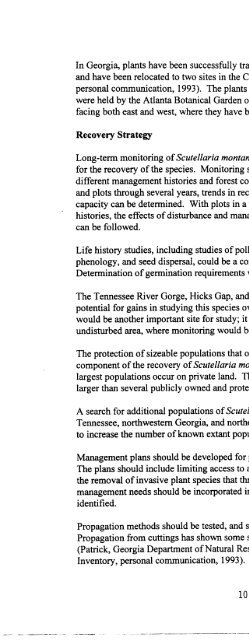Large-flowered Skullcap Recovery Plan - U.S. Fish and Wildlife ...
Large-flowered Skullcap Recovery Plan - U.S. Fish and Wildlife ...
Large-flowered Skullcap Recovery Plan - U.S. Fish and Wildlife ...
Create successful ePaper yourself
Turn your PDF publications into a flip-book with our unique Google optimized e-Paper software.
In Georgia, plants have been successfully transplanted from a site slated for development<br />
<strong>and</strong> have been relocated to two sites in the Chattahoochee National Forest (Woster,<br />
personal communication, 1993). The plants were collected while they were flowering <strong>and</strong><br />
were held by the Atlanta Botanical Garden over the winter. They were placed on slopes<br />
facing both east <strong>and</strong> west, where they have been monitored for two field seasons.<br />
<strong>Recovery</strong> Strategy<br />
Long-term monitoring ofScutellaria montana on protected l<strong>and</strong> is an important strategy<br />
for the recovery of the species. Monitoring should include permanent plots on areas with<br />
different management histories <strong>and</strong> forest compositions. By following individual plants<br />
<strong>and</strong> plots through several years, trends in recruitment, mortality, <strong>and</strong> reproductive<br />
capacity can be determined. With plots in a variety of forest types <strong>and</strong> management<br />
histories, the effects ofdisturbance <strong>and</strong> management activities on reproductive capacity<br />
can be followed.<br />
Life history studies, including studies ofpollination <strong>and</strong> germination requirements,<br />
phenology, <strong>and</strong> seed dispersal, could be a component ofa monitoring program.<br />
Determination ofgermination requirements will require laboratory studies.<br />
The Tennessee River Gorge, Hicks Gap, <strong>and</strong> Marshall Forest sites offer the greatest<br />
potential for gains in studying this species over a range ofconditions. Lookout Mountain<br />
would be another important site for study; it provides a fairly large <strong>and</strong> relatively<br />
undisturbed area, where monitoring would be useful.<br />
The protection of sizeable populations that occur on private l<strong>and</strong> is another important<br />
component ofthe recovery of Scutellaria montana. Currently, the second <strong>and</strong> third<br />
largest populations occur on private l<strong>and</strong>. These sites support populations considerably<br />
larger than several publicly owned <strong>and</strong> protected sites.<br />
A search for additional populations of Scutellaria montana throughout southeastern<br />
Tennessee, northwestern Georgia, <strong>and</strong> northeastern Alabama will also be conducted to try<br />
to increase the number ofknown extant populations.<br />
Management plans should be developed for public l<strong>and</strong> that is managed for recreation.<br />
The plans should include limiting access to areas ofhabitat for Scutellaria montana <strong>and</strong><br />
the removal ofinvasive plant species that threaten populations on those sites. Additional<br />
management needs should be incorporated into the management plans as the needs are<br />
identified.<br />
Propagation methods should be tested, <strong>and</strong> seeds should be placed in long-term storage.<br />
Propagation from cuttings has shown some success <strong>and</strong> should be investigated further<br />
(Patrick, Georgia Department of Natural Resources, Freshwater Wetl<strong>and</strong>s Heritage<br />
Inventory, personal communication, 1993).<br />
10

















